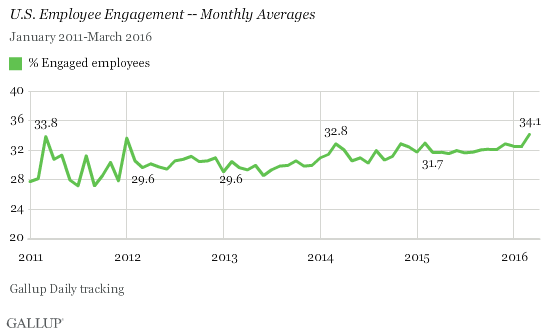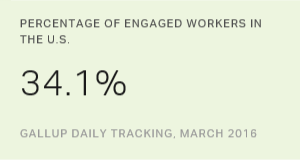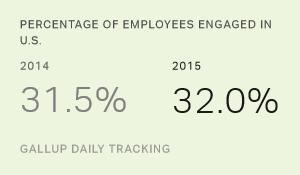Story Highlights
- Monthly employee engagement at 34.1%
- Previous record set in March 2011
- Engagement had not topped 33% since 2012
WASHINGTON, D.C. -- The percentage of U.S. workers whom Gallup considers "engaged" in their jobs averaged 34.1% in March, the highest level since Gallup began tracking U.S. workplace engagement daily in January 2011. The previous high was 33.8% in March 2011, followed by 33.6% in January 2012. Since then, employee engagement averages have been firmly locked below 33.0%.

The March average is up from 32.5% in January and February, marking an increase of 1.6 percentage points. Typically, Gallup has found that any gains or deficits in month-to-month employee engagement averages are minimal, amounting to perhaps a few tenths of a percentage point.
In March, another 49.5% of employees were "not engaged" and 16.5% were "actively disengaged."
The March 2016 employee engagement average is based on Gallup Daily tracking interviews conducted with 7,194 U.S. adults working for an employer. Gallup categorizes workers as engaged based on their ratings of key workplace elements -- such as having an opportunity to do what they do best each day, having someone at work who encourages their development and believing their opinions count at work -- that predict important organizational performance outcomes.
Engaged employees are involved in, enthusiastic about and committed to their work. Gallup's extensive research shows that employee engagement is strongly connected to business outcomes essential to an organization's financial success, such as productivity, profitability and customer engagement. Engaged employees drive the innovation, growth and revenue that their companies need.
Bottom Line
Employee engagement has generally been trending upward since 2013 and has consistently remained above 32.0% since September 2015. Yet, employee engagement has risen higher than 33.0% only three times in Gallup's history of tracking the metric.
The U.S. has long been experiencing an employee engagement crisis, similar to much of the world. The upturn in March and the relatively solid showings since September suggest that organizations are beginning to break through some of the common barriers that have caused employee engagement numbers to stagnate for several years.
Gallup has not found employee engagement to be seasonal. The metric is more dependent on factors related to an organization's performance management and human capital strategies. Gallup has also linked changes in U.S. employee engagement to changes in other employment trends, including unemployment and underemployment, suggesting a stronger job market may make U.S. workers feel better about their own job situation.
While it is too early to tell how the rest of 2016 will pan out, the year is off to a positive start. If companies continue to increase their employees' engagement and if the job market continues to make gains, monthly employee engagement averages may continue to rise.
Survey Methods
Results for this Gallup poll are based on telephone interviews conducted March 1-31, 2016, on the Gallup Daily tracking survey, with a random sample of 7,194 U.S. adults employed full or part time for an employer, aged 18 and older, living in all 50 U.S. states and the District of Columbia. For results based on the total sample of employed adults, the margin of sampling error is ±2 percentage points at the 95% confidence level. All reported margins of sampling error include computed design effects for weighting.
Each sample of national adults includes a minimum quota of 60% cellphone respondents and 40% landline respondents, with additional minimum quotas by time zone within region. Landline and cellular telephone numbers are selected using random-digit-dial methods.
Learn more about how Gallup Daily tracking works.




